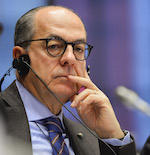
What measures should be taken in terms of innovation, in order to achieve the F2F goals?
With the ‘Farm to Fork strategy,’ we have the chance to implement a comprehensive political approach to responding to food systems. Research and innovation play a pivotal role in this respect.
We are still at the beginning of the debate. We share the goals but not the way to achieve them. We know “what” we want, but we are still working on “how” to get it. Especially in agriculture, the “how” issue is crucial in many aspects. Innovation makes no exception.
The awareness of the “what” is due to hard facts. For years the debate on agriculture and food production had been about feeding 9-10 billion humans on the planet while reducing the environmental impact. The acceleration of climate change and digitization makes things more complicated.
Today, the challenge is providing food to the world while polluting less, in an increasingly precarious climatic situation, and a potentially disrupting technological revolution ongoing.
Sustainable development is not an option. It is the only development conceivable.
“How” to do that in practice is a complicated matter. Agriculture is highly contextual. It is about diverse territories, characterized by specific soil compositions and sun irradiation conditions, often with peculiar micro-climate patterns. The agronomical practices are different, as the social structures bearing the management practices. Innovation itself is something that needs to be tested and adapted at the farm level. Sustainability in agriculture depends on many and interconnected variables. There are many indicators, but none of them applies to all places and contexts. Against this background, a pragmatic approach is the least we can offer.
Unfortunately, often the EU political debate does not take those aspects into sufficient account. Most of it resembles religious wars, irrespective of the farms’ practical situation: organic versus biotech, extensive versus intensive, natural versus chemical, climate change adaptation versus mitigation, smallholders versus ‘Big Farm’, and so on.
Thus, the first innovation I wish for the ‘Farm to Fork’ debate is that it brings us beyond these ‘monocultures’ in our heads. Innovation thrives in the more profound interconnection of diverse knowledge and experiences, even ‘soi-disant’ opposed ones. We need feasible alternatives, not slogans. That is even more important if we keep in mind the sensitiveness of innovation in food production, which often raised social acceptance issues. A more result-oriented attitude in the debate could improve the mutual understanding between farmers and consumers on their respective needs and perspectives about sustainable innovations.
Focusing on innovation at the farm level requires a combination of financial support, regulatory interventions, and investment in human capital at the EU and national level.
I give an example. Public financial support for building infrastructures is necessary to accelerate farm digitization. But we also need a proper framework for data ownership. Farmers’ training is especially critical, as well as it is the communication to society about the gains in the social and environmental sustainability of the new technologies adopted.
In my view, this means having the public sector back as the pivot of research. Since the Green Revolution – that achieved great results on the economic and social side, far less for the environment – the EU (and the US) public funds in research in agriculture has been shrinking. Corporate investment replaced most of the funding, and that is valid and useful. But it is mostly short-term and mostly based on production scales to maximize the return rate on investments as rapidly as possible. Instead, public investment can focus on long-term solutions, considering the diversity of contexts in which the innovation is to be applied, and its social and environmental sustainability.
As far as innovation is concerned, the public sector should accelerate the shift from the “innovation transfer” linear model (from the academy to research centers, then technical assistance, and, finally, farmers) to an “innovations co-creation and interconnection” one.
That requires remarkable efforts in human capital, especially.
We are not starting from scratch. The international wheat genome project’s results are a clear example of public support’s added value on the research side. On the innovation side, the 2013 CAP reform started up innovation “Operational groups” on productivity and sustainability in agriculture all over the European regions. Those groups, composed of farmers, researchers, and citizens, have been experimenting with sustainable solutions on everyday problems at the farm level. Improving and accelerating the exchange and the interconnection of those experiences is a promising pathway to apply those solutions on the farm.
On top of the support for long-term research and human capital, regulatory aspects are essential. In this perspective, I look forward to the European Commission’s orientations on the modern molecular biology techniques in agriculture. It has to be specified that those new techniques have nothing to do with the previous biotechnology methods (GMOs), the so-called “Frankenstein food”; new sustainable biotechnologies simply replicate natural evolution processes, enabling the design of new varieties that fit local needs.
The political decision on the regulatory framework for those techniques is critical to promote a varietal innovation less dependent on chemicals and big-scale production.




